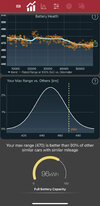Dear Folks,
My 2020 TeslaX has about 20K miles on it now, probably more than half my charging being Supercharging (I do a lot of distance driving), the rest 120V trickle-charging at home. I've been suspicious that I'm losing battery capacity, so I ran the following check on my current vacation trip. Last night, I Supercharged to 97%. When I took off this morning I started with 93% — about the amount of loss I'd expect for overnight with Sentry mode on, so nothing odd there. But... I nearly ran out of charge getting back to the motel — I was down to 2%! But the Tesla's tripmeter reported only 76KWh consumed! That's consistent with what it reported as my average mileage and the number of miles driven today. Way low for a car that's supposed to have a 100 KW battery! The car's trip data for the day computes out to barely 85 KWh battery capacity.
I can't believe my battery has degraded by 15% since I bought the car two years ago. Mostly I keep it between 10% and 90% charge, as everyone recommends. In fact, rarely do I drop much below 20%.
What gives! Suggestions? Is there any way I can investigate this further?
If I can confirm a 15% loss in 2 years and 20K miles, do folks think I'm likely to get any satisfaction complaining to Tesla Service?
Thanks!
Ctein
My 2020 TeslaX has about 20K miles on it now, probably more than half my charging being Supercharging (I do a lot of distance driving), the rest 120V trickle-charging at home. I've been suspicious that I'm losing battery capacity, so I ran the following check on my current vacation trip. Last night, I Supercharged to 97%. When I took off this morning I started with 93% — about the amount of loss I'd expect for overnight with Sentry mode on, so nothing odd there. But... I nearly ran out of charge getting back to the motel — I was down to 2%! But the Tesla's tripmeter reported only 76KWh consumed! That's consistent with what it reported as my average mileage and the number of miles driven today. Way low for a car that's supposed to have a 100 KW battery! The car's trip data for the day computes out to barely 85 KWh battery capacity.
I can't believe my battery has degraded by 15% since I bought the car two years ago. Mostly I keep it between 10% and 90% charge, as everyone recommends. In fact, rarely do I drop much below 20%.
What gives! Suggestions? Is there any way I can investigate this further?
If I can confirm a 15% loss in 2 years and 20K miles, do folks think I'm likely to get any satisfaction complaining to Tesla Service?
Thanks!
Ctein



